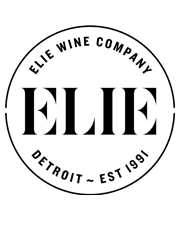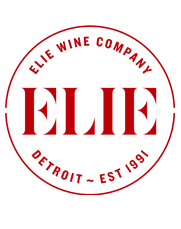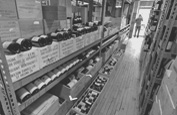Terroir Matters. 8 Two-Bottle Gift Packages: Burgundy Pairs, Contrasting Neighboring Appellations, Same Producer, Same Vintage.
Dad jokes are awful; Dad wines are awesome. Now, this aphorism is not carved in stone like the Caves Patriarche of Beaune but it’s one that holds true more often than not.
As evidence, and to honor Father’s Day, we have assembled a wonderful cross-section of Burgundy gems to suit the holiday—wine pairs that will take your significant pater on a journey of contrast through the liquid geography of Burgundy’s Golden Slopes, the Côte d’Or. Each pairing shows how wines from nearby appellations can be strikingly dissimilar or delightfully akin, a wine phenomenon that results from the interactive ecosystem of individual vineyards, collectively known as ‘terroir’.
And by the way, Dads: A skeleton walks into a wine bar and says, “I’ll have glass of Gevrey-Chambertin… and a mop.”
The Roots of Terroir; That ‘Somewhereness’
Terroir, above all, is a concept—that a wine’s taste and aroma reflect its place of origin. This reflection may be subtle or overt, but there’s plenty of science behind it. Terroir includes specific soil types, topography, microclimate, landscape characteristics and biodiversity—all features that interact with a winemaker’s choice of viticultural and enological techniques.
Every square foot of earth that supports a vine has its own unique terroir, and wine appreciation is founded on the principal that not all terroirs are created equal. Thus, the hyper-division of vineyards sites, from the most broad to the narrowest—some named climats are only a few rows in size, but produce wine markedly different than their neighbors. In Burgundy, this obsession with small, precisely delimited parcels is probably more defined than anywhere else on earth, and we will always seek out the best of those wines and share as much information about the vineyards as we can unearth… Dad pun intended.
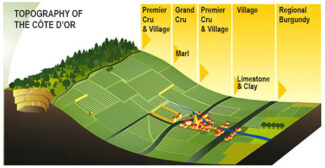
Burgundy’s Classification Obsession
Terroir matters, and nowhere more blatantly than in Burgundy’s classification system, which has four distinct levels, Grand Cru, Premier Cru, Villages and Régionale, divided up into 84 separate appellations.
Grand Cru, the top of the pyramid, represent less than 1% of the region’s total production. All of the white Grand Crus are today found in the Côte de Beaune, while all of the red Grand Crus (with the exception of the Corton family) are found in the Côte de Nuits. To be consistently exceptional requires exceptional strictures; beside being the favored sites geographically, Grand Cru wines are made with a specified grape variety from a regulated patch of land, from vines of at least 3 years of age and below a certain maximum yield per unit area of land.
Premier Cru wines account for another 5% of Burgundy’s total production, and as such, is only a slightly larger drop in the bucket. There are a few that may outperform Grand Cru wines, but they are priced accordingly. The majority of Premier Crus are from named vineyards, and the climat name will appear on the label. For example, Puligny-Montrachet Premier Cru Les Folatières assures you that this wine comes from the Folatières vineyard in the village of Puligny-Montrachet.
Village level wine is a broad and encompassing swath of terroir recognition, but it is undeniably describable: Savigny is meaty, Volnay is elegant, Vosne-Romanée is spicy, Meursault is nutty. Wines at this level have a slightly higher allowed yield per hectare, but the varietal requirements are the same. This is a slot where Burgundy’s best bargains fit; any vineyard site, Grand Cru or Premier Cru can go into a bottle labeled only after a village. Although it might sound counter-intuitive for a domain to do this, it isn’t. Wineries declassify Grand Cru and Premier Cru wines frequently, and for a variety of reasons.
Régionale wines represent the bulk of wine produced in Burgundy; they are generic, have much more relaxed standards for yields and grape types. They may be labeled Bourgogne Rouge, Bourgogne Blanc, Bourgogne Pinot Noir, Bourgogne Chardonnay or Bourgogne Aligoté—even Bourgogne Passtoutgrains, which is Gamay mixed with a lower percentage of Pinot Noir.

CÔTE DE BEAUNE: TERROIR FOR RED AND WHITE
A mnemonic device for remembering which shade of wine is best represented by the two subdivisions of the Côte d’Or, the Côte de Beaune and the Côte de Nuit: Bones are white, and the greatest of the Chardonnay-based white Burgundy (Corton-Charlemagne, Montrachet, et al) are from Beaune. Night is dark, and the greatest Pinot Noir-based reds (Domaine de La Romanée-Conti, Chambertin, et al) come from the ‘Night Slopes’—the Côte de Nuit.
Of course, the two regions make wines of either color. The Côte de Beaune is the southern half of the Côte d’Or escarpment, hilly country where, like the bowls of porridge in Goldilocks, the topsoils near the tops of the elevation are too sparse to support vines and, in the valleys, too fertile to produce top quality wine. The Goldilocks Zone (the mid-slopes) are where the Grand and Premier Cru vineyards are found, primarily at elevations between 720 and 980 feet. Drainage is good, and when vines are properly located to maximize sun exposure, the greatest Burgundies thrive and produce, year after year. The lesser, often forgettable Burgundies (generic Bourgogne) comes from the flatlands beneath the slopes; the fact that these wines are also made from Pinot Noir and Chardonnay is indication of why terroir matters. Likewise, the narrow band of regional appellation vineyards at the top of the slopes produce light wines labeled Bourgogne Hautes-Côtes de Beaune.
$102
Village: Savigny-lès-Beaune vs. Chorey-lès-Beaune
A word on ‘lès’: lès is less… distance. From the old French word for ‘near’, you can read ‘Savigny-lès-Beaune’ as meaning that the commune of Savigny is near Beaune, and—being just on the other side of the main road—Chorey is also near Beaune. Both appellations are on the far periphery of Burgundy, and often fly their wine flag under the radar.
Part of the reason for Savigny’s relative obscurity is history; until recently, red and white grapes were often vinified together, and the legal allotment of white grape (Chardonnay, Pinot Blanc or Pinot Gris) is still 15%. The fact that Savigny red wine is today nearly always pure Pinot Noir makes it a bargain—reputations linger and the wines are, among the less knowledgeable, still considered second tier. And with 1.8 million bottles of wine produced annually, there is plenty to go around.
Chorey-lès-Beaune has a slightly different problem; rich neighbors. Immediately to the east, the appellation abuts Aloxe-Corton, and for many years, Chorey wines were labeled under the more prestigious Aloxe name, but in 1970, they were granted their own appellation; the terroir, limestone-marl alluvium over stony subsoil, warranted its own slice of fame. Almost exclusively planted to Pinot Noir, the vineyards of Chorey have deeper beds of alluvial, calcium-rich gravel near Aloxe, while toward Savigny are beds of clay with pebbly limestone.
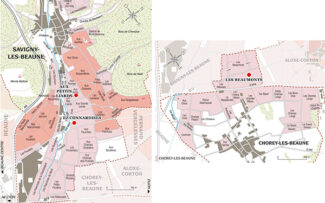
DOMAINE VINCENT LEDY
Eight years of wine school may make you think of a professional student, but Vincent Ledy took all that accumulated scholastics and applied it to one of the smallest domains in Nuits-Saint-Georges. Scarcely five acres in total, he produces six labels for a total of 8,500 bottles.
“My first vintage was 2007”, he says. “All I had was a red Hautes-Côtes de Nuits. In 2008, I increased the size of the domain a little bit when I found a very small plot for Bourgogne rouge, less than a quarter acre just opposite of Clos de Vougeot on the other side of the Beaune-Dijon road. The soil is deep clay that is reflected in the character of the wine; blackcurrant is the dominating flavor, the same every vintage. Compared with the Bourgogne Hautes-Côtes de Nuits it is very different. The Hautes-Côtes is more about cherry flavors. The maximum yield for the regional appellations is 58 hl/ha, but the yield for my Bourgogne rouge is 50 hl/ha.”
$102

Savigny-lès-Beaune – Domaine Vincent Ledy ‘Vieilles Vignes’, 2018 Savigny-lès-Beaune ($53)
Between the Hill of Corton and Beaune, the vineyards of Savigny open up on gradients that are initially gentle, but increase with the altitude. The lower slopes consist of alluvia from the Rhoin and higher up, the unique terroir of Corton takes over. Where Pernand-Vergelesses ends, exposure is southerly and the soils are gravelly with a scattering of oolitic ironstone. Lower down, the red-brown limestone becomes clay-dominated and pebbly. This produces red wines with full-fleshed notes of blackcurrant, Morello cherry and raspberry and discreet tannins.
From the Village-level lieux-dits Connardises and Aux Liards, the wine shows vivid ruby colors with garnet red tints. Violet, sweet pepper and hints of toast on the nose, followed by a silken palate and red fruit notes including cloudberry and ripe cherry.
Chorey-lès-Beaune – Domaine Vincent Ledy, 2018 Chorey-lès-Beaune ‘Les Beaumonts’ ($49)
With a scant 328 acres under vine, there are no Grand or Premier Cru climats within the boundaries despite being joined-at-the-hip to Aloxe-Corton. That’s primarily due to elevation, since Chorey occupies the lower slopes of the hill. The vineyards grow mainly Pinot Noir grapes but Chardonnay is taking an increasing share of total production. The profile of the reds is dominated by dark berry notes along with hints of licorice and underbrush; with age it evolves richer strawberry preserves and gingerbread with animal and leathery overtones.
‘Les Beaumont’ is considered one of the best climats within Chorey-lès-Beaune, located in the westernmost section near Savigny. The wine shows floral-tinged flavors of cherries, slightly stewed plum braced by cloves and sweet spice.
$168
Premier Cru: Volnay vs. Monthélie
Changes in the boundaries of Burgundy vineyards are very rare, but in 2007—egged on by the Syndicat Viticole de Volnay—the AOP authorities approved the consolidation of five Volnay Premier Cru vineyards. Fewer Premier Crus are easier for consumers to understand and remember, but it also assists growers who farm some of Volnay’s lesser-known areas.
Meanwhile, in the neighboring village of Monthélie, 16.6 acres were added to existing Premier Crus: elevated to Premier Cru status were the lieux-dits Les Clous, Le Clou des Chênes, Les Barbières and Le Clos des Toisières. The surface of Premier Cru Les Riottes was increased by 2 acres, bringing it to 10 acres total.
Volnay and Monthélie are sandwiched between Pommard and Meursault, but the wines—generally red—are closer in style to the former, although the few white wines produced in Monthélie are a close cousin to Meursault.

DOMAINE MONTHÉLIE-DOUHAIRET-PORCHERET
The Monthélie family created this domain 300 years ago—as its original vaulted cellars bear witness—and has been run by members of the Monthélie and Douhairet families ever since.
Today it is under the auspices of Vincent and Cataldina Lippo, who work in several appellations beside Volnay. Of their methodology, Vincent says, “We attach great importance to the development of healthier and more sustainable viticulture. We have always used new solutions and knowledge to develop our farming practices. So, we move forward in a thoughtful and meticulous way to better know and better anticipate. Our voluntarist policy in favor of the environment is guided by choices from the latest scientific knowledge, which are intended to be simultaneously evolutionary, economically viable and open to progress.”
$168

Volnay – Domaine Monthélie-Douhairet-Porcheret, 2018 Volnay Premier Cru En Champans ($108)
Volnay, which earned its controlled status in 1937, is perched on the hill of Chaignot and occupies a narrow, steeply sloping site. The hill itself is oriented slightly differently than the general run of the countryside; the vines face south-east rather than east. The terroir is composed of oolitic limestone with a superficial similarity to the reddish igneous rock of the Morvan district, pink in color with pale green inclusions and overlain by banks of schist.
The Pinot Noir-based wines of Volnay are typically elegant and aromatic with scents of violet, gooseberry and cherry; with age, a characteristic spiciness emerges with notes of game and cooked prune.
This sumptuous Volnay comes from the Champans vineyard, located in the heart of the Volnay with east and south-east exposures; it is entirely surrounded by other Premier Cru climats. The soil in Champans is rocky, made of hard and tight limestone with a red thin top soil; the upper part of the slope has more friable marl while the bottom sits on sediments. The average age of the vines in the domain’s parcel is around 40 years. The wine displays violet aromas, rich red stone fruit with elegantly integrated acidity and transparent, refined tannins.
Monthélie – Domaine Monthélie-Douhairet-Porcheret, 2018 Monthélie Premier Cru Le Meix Bataille ($60)
Monthélie looks out across the first hills of the Côte de Beaune in a situation Burgundian scholar Pierre Poupon describes as, “Prettily nestled into the curve of the hillside like the head of Saint John against the shoulder of Jesus.” So committed to wine-growing is the commune that a local proverb goes, “a Monthélie chicken will die of hunger at harvest time.”
The vineyards of Monthélie lie on pebbly terroir made of Bathonien limestone overlain by red clay and marl. Some of the vines are grown on the Volnay side, and some on the Auxey-Duresses side are planted in Argovien limestone. Exposures and exposures are easterly or westerly, depending on the run of the country, with altitudes ranging from 800 – 1000 feet.
The Le Meix Bataille climat sits on the Volnay border next to Clos des Chênes, where deep red soils gives the wine a dark bramble fruit profile: blackberry and black raspberry. There is nice density to the palate, but precise definition; the finish is long, juicy and fresh.
$230
Premier Cru: Pommard vs. Volnay
The Pommard appellation covers only red wine, and as such, its renown is based on the lusciously ripe, deeply intense richness that Pinot Noir seems only able to achieve in Burgundy. With primarily mid-slope vineyards, Pommard boasts 28 Premier Crus which run almost uninterrupted from the commune boundaries of Beaune in the north to Volnay in the south. In fact, the only break in this belt of prized mid-slope vineyards is provided by the streets and houses of Pommard village itself.
Volnay is a small, early ripening and sunny appellation, and in the average quality of its wine is among the highest in the Côte d’Or; there are only seven hundred acres of vines and almost 115 of them are classed as Premier Cru.
Pommard and Volnay are less than a mile apart yet their wines are markedly different. Even more striking is the fact that the most-southerly vineyards of Pommard are separated from the most-northerly vineyards of Volnay by no more than an imaginary line: the commune boundary that divides the two parishes. Over the centuries, the wines of Pommard and Volnay have alternately shared popularity according to the fashions of the age. When powerful, full-bodied wines are in favor (as in the current global market), Pommard enjoys the limelight. But when silkier, smoother wines are in demand, Volnay takes center stage.

DOMAINE J.M. BOILLOT
In the latter part of the 20th century, a new generation of winemakers in Burgundy determined to improve the overall quality of wine, often by breaking away from the family domain. Jean-Marc Boillot was one of them. In 1984, after vinifying 13 vintages for his grandfather Henri Boillot, he walked out in protest, and promptly became the winemaker for Olivier Leflaive. Over the next four years he produced wines from 5-acres of vineyards and bottled under his own label, and these wines so impressed Boillot’s grandfather that he bequeathed him half his vineyards. Today Boillot runs his domain from his grandfather’s house and cellars in the village of Pommard. Jean-Marc’s maternal grandfather was the late Etienne Sauzet, from whom he also inherited exceptional vineyards.
$230
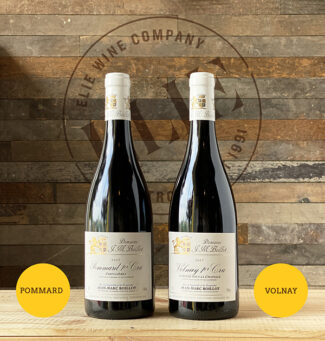
Pommard – Domaine J.M. Boillot, 2017 Pommard Premier Cru Jarollières ($115)
A mosaic of parcels and enclosed plots surround a substantial, charming village which takes its name from the ancient goddess of the garden, Pomona, divinity of the garden. Côte de Beaune is renowned for its great white wines; Pommard is the exception to prove the rule with tannic, robust wines made exclusively from Pinot Noir. On the lower ground the soil is ancient alluvium, while on-slope, the clay-limestone soils are well drained thanks to the inclusion of rock debris. Higher still are Jurassic marls, brown calcic soils, and brown limestone soils. And in places, the soil is reddened by the presence of iron. In the mouth, wines from Pommard are quite intense with firm and powerful tannins.
Jarollières is three, east-facing acres bordered by a stone wall upslope. Soils are limestone, with a large percentage of clay; one-third of the vines were planted in 1925; the rest in 1960s, 1970s and 1990. Visually, this wine shows a deep red color, to the nose, the bouquet gives off aromas of blueberry and gooseberry, evolving towards hints of chocolate and leather.
Volnay – Domaine J.M. Boillot, 2017 Volnay Premier Cru Carelle sous la Chapelle ($115)
Like Pommard, Volnay produces only red wines, which are highly perfumed, well-structured and elegant. The white wines made in the Volnay area are sold under the Meursault appellation name, and it should be noted that red Volnay-Santenots wines are actually from Meursault. The most highly regarded sites in Volnay are steeply-sloped, very calcareous with well-drained, light brown soil and sit at the highest end of parcels while toward the bottom, the terroir is more clay-driven with earth that vacillates between brown and red.
Volnay has traditionally been thought of as the most feminine of Burgundies, although certain terroirs produce more vigorous and muscular versions. Its aromas are of violet, gooseberry, cherry, and with age develop into spices, game and cooked prune. It has an immediate appeal which, added to a slight natural precocity, means it can be fully open while still relatively young.
‘Carelle sous La Chapelle’ is named for it shape; carré means square, although the climat is oblong. The soil has a perfect percentage of brown clay, marl and soft limestone, planted at the same elevation as Volnay‘s famous ‘En Champans’ and ‘Taillepieds’. The average vine age is 60 years old, and the wine is extremely perfumed with beautifully ripe raspberry, cherry and strawberry liqueur with the bite of rhubarb freshness above supple, ripe tannin.
$566
Grand Cru: Corton vs. Corton
The hill of Corton rises in majesty above the quaint village of Aloxe, lording over the only Grand Cru for Pinot Noir in the entire Côte de Beaune. Its Grand Crus reds are described simply as Corton or Corton hyphenated with other names. These vineyards cover the southeast face of the hill of Corton where soils are rich in red chalk, clay and marl. Dense and austere when young, the best Corton Pinot Noir will peak in complexity and flavor after about a decade, offering some of the best rewards in cellaring among Côte de Beaune reds.
The lauded whites of the village are made within Corton-Charlemagne, a cooler, narrow band of vineyards at the top of the hill that descends west towards the village of Pernand-Vergelesses. Here, the thin and white stony soils produce Chardonnay of exceptional character, power and finesse.

THIBAULT LIGER-BELAIR
The estate (originally called Comte Liger-Belair) was created in 1720 in Nuits-Saint-Georges, and soon became one of the most important wine growing and trading houses in Burgundy. After many years and successive generations had met with varying degrees of success, Thibault Liger-Belair took over in 2001, and found the 20-acre estate in need of some attention. His immediate switch to organic farming was a matter of necessity as much as responsible stewardship: “The vineyards were in a bad condition, with compacted soils. I couldn’t do anything else other than organics,” he says, and in 2004, he discovered biodynamics: “I saw a change in my vineyard, which went from grey soils to brown/red and then sometimes to black.”
Still, his overarching philosophy is that each vineyard needs something different: “I don’t like 100% of anything: new barrels, whole clusters, etc. My job is to decide which grapes we have and then decide a viticulture and winemaking approach.”
In 2018, he made wine from 23 different appellations and purchased grapes from a ten more, where he had worked the vines himself. “We don’t purchase grapes where we don’t do the work,” he maintains.
$566
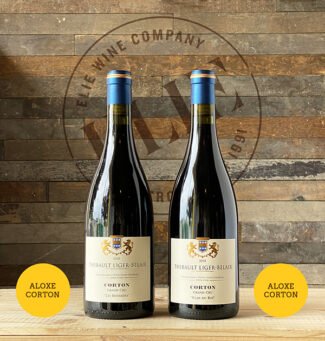
Aloxe-Corton – Thibault Liger-Belair, 2016 Corton ‘Les Renardes’ Grand Cru $283
Les Renardes is a lieu-dit within the commune of Aloxe-Corton and a part of the Corton Grand Cru appellation for red wines from Pinot Noir. A section at the top of the property may also produce Chardonnay for the Corton-Charlemagne Grand Cru appellation. The vineyard is walled, 35 acres located at the northeast end of the commune, high on the eastern slopes of the Montagne de Corton hill, just below the Le Corton. The terroir is characterized by pebbly, marlstone soils rich in iron oolite. These reputedly impart the rich, gamey character for which Corton Renardes wines are known.
Considered one of the best Cortons of the 2016 vintage, the wine is 40% whole bunch. Rich dense and sensual style of Corton, lacking the rugged foxy notes which some attribute to Renardes; instead, it is full ripe rounded, graceful. Blessed with plenty of oak, it integrates it well while the whole bunches leave a drier sensation at the back of the palate which will settle in as the wine opens up.
Aloxe-Corton – Thibault Liger-Belair, 2016 Corton ‘Clos du Roi’ Grand Cru $283
The ‘walled vineyard of the King’ is one of the most highly regarded climats in Corton; it is 26 acres in the very center of the southeast-facing side of the Corton hill, characterized by pebbly, potassium-rich marlstone soils with a reddish tinge from the iron seam on the mid-slope—an area of the hill generally viewed as better-suited to Pinot Noir than Chardonnay, which is more commonly planted on the western side. The classic Clos du Roi is rich and relatively tannic, quite austere in its youth but able to develop well with age. Flavors include violets, forest berries, leather and earthy notes.
Unlike Les Renardes, Liger-Belair’s Clos du Roi contains no whole bunches, and production was limited to two barrels, or roughly 300 bottles. The wine has a cool nose with notes of rose petals, red and dark berries that also flashes hints of freshly turned earth. There is outstanding richness and drive to the palate, which shows blueberry, blackcurrant pastille, orange zest with licorice and mint through the powerful and broad-shouldered finish.
CÔTE DE NUITS: TENDER IS THE NIGHT
Named after its principal town, Nuits-St-Georges, the Côtes de Nuits produces the greatest red wines of Burgundy. As in its counterpart, the Côte de Beaune, not all the wines are created equal; the best are from a narrow, mid-slope band of limestone and from vineyards facing south-east to maximize exposure to the sun. This precise mix of soil and sunshine allows Pinot Noir to showcase an extraordinary range of textures and flavors.
Côte de Nuits is subdivided into eight designated village; Chambolle-Musigny, Fixin, Gevrey-Chambertin, Marsannay (which also has a separate designation for rosé), Morey-Saint-Denis, Nuits-Saint-Georges, Vosne-Romanée and Vougeot. The area includes 24 superlative vineyard sites clustered around six communes and designated Grand Cru and over a hundred Premier Cru sites. In addition, there are two district appellations: Côte de Nuits-Villages, which are wonderfully elegant and affordable reds that are ready to drink upon release, and Bourgogne Hautes Côte de Nuits, which consists of some 20 villages in the hills west of the vineyards of the Côte de Nuits that produce wines with this appellation.
$162
Village: Chambolle-Musigny vs. Gevrey-Chambertin
Along with Vosne-Romanée, the communes of Chambolle-Musigny and Gevrey-Chambertin round out ‘the Big Three’ of Burgundy reds. Much has been written to compare the last two, perhaps best summarized by Nadine Gublin of Domaine Jacques Prieur: “Chambertin has a colder climate and tends to have more structure than Musigny; Musigny is more forward and elegant; it has a body that is very silky and satiny, while Chambertin has greater finesse, but needs more time to reveal itself—it is more serious and discreet.”
There is a marked difference in size, too: Chambolle-Musigny is relatively small, covering five hundred acres, of which 180 are Premier Cru—the appellation has 24. There are also two Grand Cru climats, Bonnes-Mares, which links its vineyards to those of Morey-Saint-Denis, and Musigny which overlooks the Clos de Vougeot. The prestigious Premier Cru site Les Amoureuses, however, is doubtless on their level.
Gevrey-Chambertin is the northernmost among the Big Three. With around 1,500 vineyard acres, it counts nine out of the 24 Côte de Nuits Grand Cru vineyards within its confines. Gevrey-Chambertin wines are recognized as rich, concentrated and masculine as opposed to the southernmost of the three, the more feminine Chambolle-Musigny.
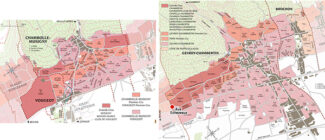
PHILIPPE JOUAN
With fewer than ten acres under vine, the tiny domain of Philippe Jouan does not produce at volumes that move the needle on most output charts (five cuvées), but the quality is frequently over the top. Situated in the village of Morey-Saint-Denis the estate is run by Phillipe Jouan, the fifth generation of his family to make Pinot Noir here. Harvests are typically de-stemmed, with 10 to 15% whole-bunch fermentation in cooler vintages; the musts tend to undergo short macerations of 12 to 14 days and are then pressed off with a 100-year-old wooden press bought by Philippe’s great-grandfather. The wines typically see 25 to 40% new oak, the majority from François Frères.
$162
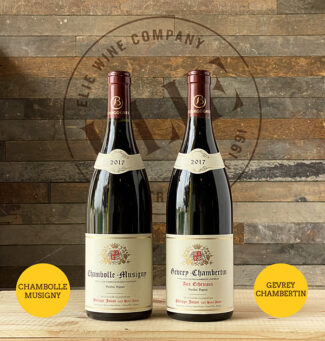
Chambolle-Musigny – Philippe Jouan ‘Vieilles Vignes’, 2017 Chambolle-Musigny ($81)
The vines of Musigny face east at ‘magic’ altitudes between 820 and one thousand feet, where there is only a shallow covering of soil overlying the parent rock; fissures in the hard Jurassic limestone allow the roots to seek nourishment deep within the sub-soil, while boulders and gravels in the valley bottom ensure good drainage. The wines are bright ruby upon release and darken over time with no loss of intensity. Its bouquet is easily recognizable; violets, raspberry, strawberry and with age, tends towards spiced ripe fruits and prune and towards truffle, underbrush and animal pelt notes.
After several years of reduced harvests due to frost damage, winemakers in Chambolle-Musigny are apt to describe the wonderful 2017 vintage in a single word: ‘Triumphant.’ Jouan’s Village-level Musigny is a wine of transparency, precision and delicacy with luscious red cherry, nutty oak and fresh earth. Delicate, elegant tannins lead into a long, floral finish.
Gevrey-Chambertin – Philippe Jouan ‘Vieilles Vignes’, 2017 Gevrey-Chambertin ‘Aux Echezeaux’ ($81)
The storybook terroirs of Gevrey-Chambertin include nine Grand Cru vineyard plots on the upper reaches of the appellation while the Premier Crus are located on the mid-slopes, south of the Chambertin village. Below are the appellation Villages vines, on brown calcic or limey soils. The vines reap the benefit of marls covered with screes and red silt washed down from the plateau. These stony mixtures confer elegance and delicacy on the wine while the clay marls, which contain rich deposits of fossil shell-fish, add body and firmness. Exposures vary from east to south-east, producing wines that exemplify everything a red Burgundy should be; bright ruby in youth, turning to deep carmine or dark cerise with age while strawberry, mulberry, violet, mignonette and rose petal make a bouquet of spontaneous aromas. More maturity brings out anise, leather and fur, with gamey notes and hints of underbrush.
Aux Echézeaux is a climat filled 80-year-old vines directly adjacent to Grand Cru Charmes-Chambertin. It produces a rich, stylish Gevrey with mingled black cherries, plums and subtle earthy nuances studded with notes of spice. Still a young wine, this needs ample breathing time, and will benefit immensely with a couple more years of age.
$236
Premier Cru: Gevrey-Chambertin vs. Morey-Saint-Denis
Where Gevrey-Chambertin is huge and almighty, its neighbor to the south, Morey-Saint-Denis, is small and mighty. Boasting 4 Grand Cru (5 if you count Bonnes Mares, of which 8.6 acres lie within MSD) and 20 Premier Cru vineyards, Morey-Saint-Denis is Pinot Noir country through and through. Although a few pockets of Chardonnay exist at the highest elevations, more than 95% of the vines are Pinot; soils are ideal: thin brown clay topsoils with a subsoil of limestone that runs across the whole region. Not only that but the entire appellation is located on the perfect east-south-east facing slopes which catch all the gentle rays of the morning sun and drains away any rainfall, forcing the grapes to dig deep into the limestone for moisture and nutrients. As such, it is one of the very few appellations where there is more land rated ‘Grand Cru’ than Premier Cru or Village—of the total 275 acres, 27% are classified as Village, 35% Premier Cru while a whopping 100 acres (38%) are classified Grand Cru.
Like Gevrey-Chambertin, the wines of Morey-Saint-Denis are firm and opulent, often referred to as masculine; a power struggle between body and fruit that in ideal vintages resolves itself as balance.
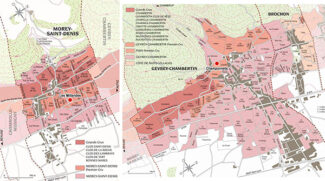
DOMAINE HERESZTYN-MAZZINI
Florence and Simon Heresztyn-Mazzini hail from different winemaking regions—Florence from Burgundy and Simon from Champagne. After ten years of working Heresztyn-owned vineyards in Gevrey-Chambertin, the couple decided to start their own venture on 14 acres spread across the villages of Gevrey-Chambertin, Morey-Saint-Denis, and Chambolle-Musigny. 2012 was their first vintage. Florence maintains, “We are closely attached to the Côte de Nuits and its unique terroirs and work relentless to bring out the region’s best qualities. Simon and I make it a point of personal pride to respect the region’s soils and natural environment.
$236
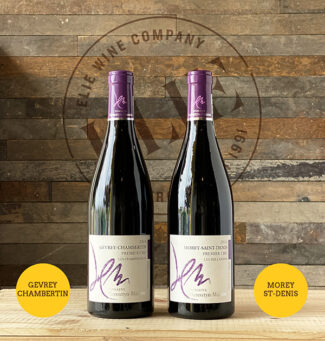
Gevrey-Chambertin – Domaine Heresztyn Mazzini, 2014 Gevrey-Chambertin Premier Cru Champonnets ($118)
As previously mentioned, Gevrey-Chambertin is the largest commune in the Côte de Nuits, producing to highly-concentrated and full-bodied wines. Premier and Grand Cru wines are unmatched elsewhere in sheer power, with dark-fruit flavors, firm tannins and all the complexities of earthiness, smoke and spice that Pinot Noir can display in such rare terroirs.
Champonnets is an 8-acre climat just south of Gevrey-Chambertin, on the northern edge of the Grand Cru hillside. Unusually, it sits on a northeast-facing slope on the edge of the Combe de Lavaux, a valley that runs perpendicular to the famous Cote d’Or escarpment. Muscular, dense and powerful, the wine bursts with cherry, black currant, violet and graphite flavors shrouded in smoky oak.
Morey-Saint-Denis – Domaine Heresztyn-Mazzini, 2014 Morey-Saint-Denis Premier Cru Les Millandes ($118)
Morey Saint-Denis forms a bridge between the wines of Gevrey-Chambertin and those of Chambolle-Musigny. The top estates have soils rich in limestone and clay dating from the Middle Jurassic: white Bathonien Oolite is found up-slope and fossiliferous Bajocien limestone below. The best of the east-facing vineyards are in the Goldilocks Zone, around 800 feet. The wine tends to produce a bouquet of both black and red berries, and sub-notes include violet, and cherry liqueur. When older it often evokes wildwood scents of game, leather and truffle.
At ten acres, Les Millandes is one of the largest Premier Cru climats in central Morey-Saint-Denis, located just north of the town itself, among a strip of Premier Cru climats that lie at the base of the Côte d’Or below the Grand Cru hillside. The wine is easily referred to as ‘noble’, with a nose of great complexity, including scents of coffee, cherry, raspberry and blueberry and displaying an elegant palate with tannins by now well-integrated.
$163
Village: Vosne-Romanée vs. Nuits-Saint-Georges
Originally simply called Nuits, Nuits-Saint-Georges expanded its name in 1892, adding its most renowned vineyard to its name. The wines are known for being bigger, bolder, fruitier, and more tannic than the elegant, floral, spicy and highly nuanced wines of nearby Vosne-Romanée. The town sits at the base of a valley formed by the river Meuzin; to the north of the town, the vineyards are more than a thousand feet in elevation, with soils full of pebbles as well as limestone and a little clay. Despite a rich history, Nuits-St-Georges has no Grand Cru vineyards. Instead, the best vineyards are classed as Premier Cru, reportedly because of the modesty of the appellation’s leading winemaker, Henri Gouges when it was created in 1936. It doesn’t really matter since the renown and quality of Nuits-St-Georges speak for themselves.
Next door Vosne-Romanée is a small commune with a brobdingnagian reputation shored up by a raft of Grand and Premier Cru vineyards. The commune’s area is grouped together with Flagey-Echézeaux, and while the villages are entirely separate, their finest vineyards are clustered together immediately north of Vosne-Romanée and take that latter title. Although the entire surface area of Vosne-Romanée Grand Cru vineyards is only 67 acres, Flagey-Echézeaux (with the Echézeaux and Grands-Echézeaux sites) has more Grand Cru surface area than either Premier Cru or Villages level combined.
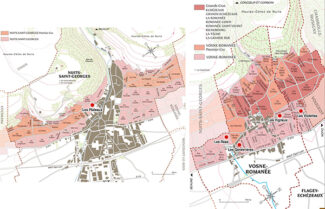
DOMAINE MONGEARD-MUGNERET
The name ‘Mongeard’ first makes an appearance in Burgundy in 1786, where records show a Mongeard working as vigneron for Domaine de la Romanée-Conti. Skip forward to 1945, when at the age of 16, Jean Mongeard (whose mother was from Famille Mugneret) made wine which he sold by the barrel to négociants. The entire 1945 crop was purchased by Baron le Roy, Marquis D’Angerville, and Henri Gouges, who suggested that the young Mongeard start bottling the wines himself.
In 1975, Jean’s son Vincent began working alongside his father and became responsible for viticulture and vinification of the domaine’s wines. He persuaded his father to return to the traditional method of filtering only in certain vintages. Upon his retirement in 1995, Vincent assumed complete leadership of the domain, which now covers more than 75 acres split among 35 appellations.
$163

Vosne-Romanée – Domaine Mongeard-Mugneret, 2019 Vosne-Romanée ($82)
“Bourgogne has produced nothing better than this little corner where all her charms come together,” wrote Gaston Roupnel, a celebrated historian of the French countryside. “Vosne-Romanée is the central pearl in Bourgogne’s necklace.” The vineyards lie either at the top of the slope or at its foot, on either side of the Grand Cru climats, and in some cases reach the same altitude. The soils are limestone mixed with clay-rich marls; soil depth varies from some a few inches to a few feet deep, while the exposures are easterly. The wines are fiery red and show bright red fruit over spices; strawberry, raspberry, bilberry, or blackcurrant are the most frequently used descriptors. These refined and well-blended aromas evolve with age into cherries-in-brandy, preserved fruits, leather and fur, and woodland scents.
Drawn from the lieux-dits Les Genévrières, Les Réas, Les Violettes and Les Vigneux, this wine is remarkably good for a Villages-level wine. A spicy nose combines notes of anise and sandalwood with those of plum, dark cherry and a subtle application of wood. The velvety palate possesses both excellent volume and density while exhibiting good power on a solidly tannic finish.
Nuits-Saint-Georges – Domaine Mongeard-Mugneret, 2019 Nuits-Saint-Georges ‘Les Plateaux’ ($81)
Nuits-Saint-Georges is the second largest of the 26 commune titles in the Côte d’Or, slightly smaller than Beaune. There are around 800 acres of vineyards within its boundaries, producing almost exclusively red wine, which tend to be intense and deeply colored wine showing pronounced, complex fruit flavors, predominantly cherries, blackcurrants and violets and often with an earthy component of truffles and spices.
From the Villages-level lieu-dit Les Plateaux, the wine exhibits notes of raspberries, orange rind, forest floor and peonies framed by a deft touch of toasty new oak. Layered and concentrated, revealing the long-lived structure of classic Nuits-St-Georges.
$498
Grand Cru: Vougeot vs. Flagey-Echézeaux
Flagey-Echézeaux is a small village squeezed in between Vougeot and Vosne-Romanée. Flagey contains two famous Grand Crus; Echézeaux and Grands Echézeaux, along with a few areas with lesser appellations. Unusually, all the Villages and Premier Cru wines are labelled as Vosne-Romanée. Lying alongside the Clos de Vougeot, Grands Echézeaux encompasses 25 acres; compared to Vougeot, Grands Echézeaux has a similarly sturdy style, but is more gamey, more rustic and not as elegantly earthy.

$498

Vougeot – Domaine Mongeard-Mugneret, 2017 Clos de Vougeot Grand Cru ($239)
Founded around 1110 AD by the monks of nearby Cîteaux, the slopes at the upper end of the Clos abut the vineyards of Musigny and Grands Echézeaux. In the center, at about 830 feet of altitude, the soil is shallow and brown, with clay overlying broken limestone. The lower portion, around 790 feet, has a brown soil which is deeper and lies on a layer of marl, rich in clay and alluvium. The vineyard is divided among numerous owners, so no single description can be applied to all the wines, although common features are a very intense strawberry red color, a suave bouquet redolent of springtime roses and violets with blackberry and wild mint.
Background floral notes combine with ripe, more somber notes of espresso, bonfires and nutty new oak with a hint of menthol. The wine shows good density throughout, with powerful, tautly muscular flavors that manage to retain a silken mouthfeel before an explosive finish.
Flagey-Echézeaux – Domaine Mongeard-Mugneret, 2017 Echézeaux Grand Cru ($259)
No appellation bears the name ‘Flagey-Echézeaux’ and the vineyards it encompasses are more than a mile from town. It is home to the famous Grand Cru vineyards Echézeaux and Grands Echézeaux. Belonging geologically to the Jurassic era the Grands Echézeaux vineyards are fairly homogeneous with the upper part of the Clos de Vougeot. Soil is clay-limestone overlying Bajocien limestone. The Echézeaux climats have more diverse soils largely bajocien marls with a pebbly overlay. Altitudes vary from 750 feet to nearly a thousand, with a 13% gradient at mid-slope. The wines tend to be shaded towards the darker tones of magenta and purple with a bouquet redolent of animal, spice notes, underbrush, and prune, evolving with age towards musk, leather, fur and mushroom.
Blended from the domain’s various holdings and assembled in tank prior to bottling. The brooding but expressive nose reveals toasted oak, deep purple fruit and a spice-box of scents including hoisin and umami. With breathing space, the wine unfolds with considerable fruit, blackberry and ripe Damson, and a muscular finish filled with chewy tannins.
- - -
Posted on 2022.06.23 in Chambolle-Musigny, Savigny-lès-Beaune, Chorey-lès-Beaune, Monthélie, Aloxe-Corton, Morey-Saint-Denis, Vougeot, Nuits-Saint-Georges, Vosne-Romanée, Pommard, Volnay, Gevrey-Chambertin, France, Burgundy, Wine-Aid Packages
Featured Wines
- Notebook: A’Boudt Town
- Saturday Sips Wines
- Saturday Sips Review Club
- The Champagne Society
- Wine-Aid Packages
Wine Regions
Grape Varieties
Aglianico, Albarino, Albarín Blanco, Albarín Tinto, Albillo, Aleatico, Arbanne, Aubun, Barbarossa, barbera, Beaune, Biancu Gentile, bourboulenc, Cabernet Franc, Cabernet Sauvignon, Caino, Caladoc, Calvi, Carcajolu-Neru, Carignan, Chablis, Chardonnay, Chasselas, Clairette, Corvina, Cot, Counoise, Erbamat, Ferrol, Fiano, Frappato, Friulano, Fromenteau, Fumin, Garnacha, Gewurztraminer, Godello, Graciano, Grenache, Grolleau, Groppello, Juan Garcia, Lambrusco, Loureira, Macabeo, Macabou, Malvasia, Malvasia Nera, Marsanne, Marselan, Marzemino, Melon de Bourgogne, Merlot, Mondeuse, Montanaccia, Montepulciano, Morescola, Morescono, Moscatell, Muscadelle, Muscat, Natural, Nero d'Avola, Parellada, Patrimonio, Petit Meslier, Petit Verdot, Pineau d'Aunis, Pinot Auxerrois, Pinot Blanc, Pinot Gris, Pinot Meunier, Pinot Noir, Poulsard, Prieto Picudo, Rondinella, Rousanne, Roussanne, Sangiovese, Sauvignon Blanc, Savignin, Semillon, Souson, Sparkling, Sumoll, Sylvaner, Syrah, Tannat, Tempranillo, Trebbiano, Trebbiano Valtenesi, Treixadura, Trousseau, Ugni Blanc, vaccarèse, Verdicchio, Vermentino, Viognier, Viura, Xarel-loWines & Events by Date
- April 2024
- March 2024
- February 2024
- January 2024
- December 2023
- November 2023
- October 2023
- September 2023
- August 2023
- July 2023
- June 2023
- May 2023
- April 2023
- March 2023
- February 2023
- January 2023
- December 2022
- November 2022
- October 2022
- September 2022
- August 2022
- July 2022
- June 2022
- May 2022
- April 2022
- March 2022
- February 2022
- January 2022
- December 2021
- November 2021
- October 2021
- September 2021
- August 2021
- July 2021
- June 2021
- May 2021
- April 2021
- March 2021
- February 2021
- January 2021
- December 2020
- November 2020
- October 2020
- September 2020
- August 2020
- July 2020
- June 2020
- May 2020
- April 2020
- March 2020
- February 2020
- January 2020
- December 2019
- November 2019
- October 2019
- September 2019
- August 2019
- July 2019
- June 2019
- May 2019
- April 2019
- March 2019
- February 2019
- January 2019
- December 2018
- November 2018
- October 2018
- September 2018
- August 2018
- July 2018
- June 2018
- May 2018
- April 2018
- March 2018
- February 2018
- January 2018
- December 2017
- November 2017
- October 2017
- September 2017
- August 2017
- July 2017
- June 2017
- May 2017
- April 2017
- March 2017
- February 2017
- January 2017
- December 2016
- November 2016
- October 2016
- September 2016
- August 2016
- July 2016
- June 2016
- May 2016
- April 2016
- March 2016
- February 2016
- January 2016
- December 2015
- November 2015
- October 2015
- September 2015
- August 2015
- July 2015
- June 2015
- May 2015
- April 2015
- March 2015
- February 2015
- January 2015
- December 2014
- November 2014
- October 2014
- September 2014
- August 2014
- July 2014
- June 2014
- April 2014
- March 2014
- February 2014
- January 2014
- December 2013
- November 2013
- October 2013
- September 2013
- August 2013
- July 2013
- June 2013
- May 2013
- April 2013
- March 2013
- February 2013
- January 2013
- December 2012
- November 2012
- October 2012
- February 2004
Search
